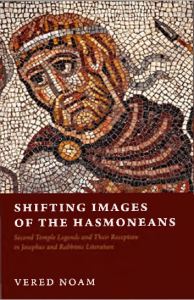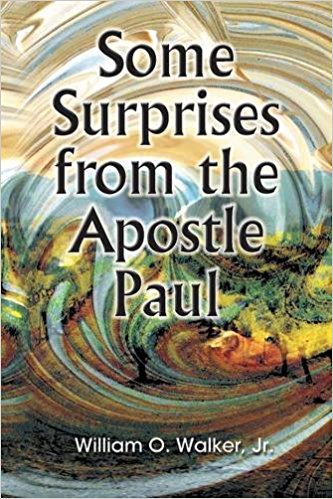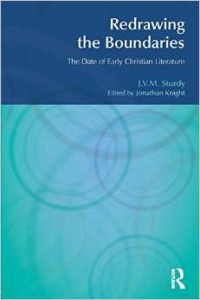Continuing….
In this post I begin by addressing Peter Kirby’s final argument against Rivka Nir’s case for the John the Baptist passage in Josephus’s Antiquities being an interpolation. (I will return to his intermediate arguments in the next instalment.)
Kirby zeroes in on the logical fallacy of Nir’s argument as he (Kirby) has read it. Unfortunately, Kirby’s rewriting of Nir’s case relies on an interpretation of Nir’s concluding paragraphs that overlooks her preparatory argument and introductory statements through which that conclusion should be read. As a result, he omits two core elements that Nir has stressed in her article. Kirby summarizes Nir’s case this way:
Rivka Nir’s argument, then, if it is boiled down to the basics, runs something like this:
(a) Groups at the margin of Second Temple Judaism, such as the Qumran sect, had beliefs regarding “inner purification,” a “prior commitment to a righteous way of life,” as a “prerequisite for the efficacy of bodily immersion.”
(b) Jewish-Christian sects had similar beliefs regarding “inner purification,” a “prior commitment to a righteous way of life,” as a “prerequisite for the efficacy of bodily immersion.” (The point is also made that it can be considered an alternative to the function of the Temple cult.)
(c) Other Christian sects held that “Christian baptism itself bring[s] about forgiveness of sins.”
(d) Accordingly, the “Josephus account of John the Baptist may reflect an intra-Christian dispute concurrent with the formation of the Christian rite of baptism during the first centuries CE.” (emphasis added)
(e) “Josephus, as is well known, remained a faithful Jew. He was neither initiated into one of the JewishChristian sects, nor did he convert to Christianity.”
(f) “Thus, the inevitable conclusion is that the description of John’s baptism, as provided in the passage under review, was not written by Josephus, but was rather interpolated or adapted by a Christian or Jewish-Christian hand.”
By presenting the above points as the essence of Nir’s argument Kirby is able to make the following “valid” logical criticism:
When we widen the lens just a little, to include a view of the actual audience of Josephus, which was Hellenistic, instead of keeping a strict focus on Judaism and Christianity, as Rivka Nir does, we can clearly see the fallacy of the idea: not Jewish, therefore Christian. Yes, it may be that the distinction Josephus was making was in opposition to an idea that was not Jewish. It is a fallacy of the excluded middle, however, to conclude on this basis that the distinction is being made in contrast to Christian ideas. There are many different beliefs that are not Jewish but also not Christian.
That Josephus had mystery religions and their beliefs regarding forgiveness of sins, just by being washed in certain rites, in view here, seems probable.
But if we go back and read Nir’s essay as it led to her conclusion, we see that Nir is not so logically naive after all and that Kirby’s “boiled down basics” have glossed over key points in her presentation.
. . . But, more than anything else, what clinches the Christian sectarian identity of Johannine baptism in this passage is its characterization as ‘a consecration of the body’ on condition that ‘the soul was already thoroughly cleansed by righteousness’.44 It is an immersion combining external physical purification with inner, moral, spiritual purification, where the latter is a prerequisite for the former.45 Baptism will bring about ritual purification of the body only if the soul has already been purified by righteousness; that is, only if baptism has been preceded by repentance on the part of the candidate. . .
44) Jewish Antiquities, XVIII, 117.
45) As noted, n. 17 above, the explanatory clause uses wording implying a condition. See Meier, ‘John the Baptist in Josephus’, p. 231; idem, A Marginal Jew, II, pp. 57-58.
(Nir, p. 45)
The debated point Kirby misses is the place of ritual purification of the body. Does baptism, in addition to cleansing one of moral sin, also cleanse the physical body of ritual impurity? (See the side box.) John’s baptism, as explained in the Josephus passage, answers that it does also make one’s body ritually pure IF one has previously turned from sin to righteous living.
That is the point under debate in Josephus’s description of John’s baptism — is the body also ritually pure and under what conditions?
Kirby has overlooked that central point and reduced Nir’s argument to one of merely asking if baptism itself has the power to forgive sin or does baptism “work” only if one repents before baptism. He has missed the importance of the question of bodily purification.
Nir’s argument holds up because the debate over the relation of baptism to ritual purification of the body is only evidenced (as far as I am aware) in sectarian Jewish and Jewish-Christian works. It is not part of mystery religion teachings – at least I know of no evidence that it is. Nor do I know if Josephus anywhere else indicated any interest in polemicizing against rituals of mystery religions.
So a correct boiling down of Nir’s argument to its basics should run something like this:
(a) Groups at the margin of Second Temple Judaism, such as the Qumran sect, had beliefs regarding “inner purification,” a “prior commitment to a righteous way of life,” as a “prerequisite for the efficacy of bodily immersion” — and that efficacy includes ritual bodily purification as well as inner righteousness.
(b) Jewish-Christian sects had similar beliefs regarding “inner purification,” a “prior commitment to a righteous way of life,” as a “prerequisite for the efficacy of bodily immersion.” (The point is also made that it can be considered an alternative to the function of the Temple cult by making the body ritually pure.)
(c) Other Christian sects held that “Christian baptism itself bring[s] about forgiveness of sins” — and disputed the value of baptism making the body ritually pure.
(d) Accordingly, the “Josephus account of John the Baptist may reflect an intra-Christian dispute concurrent with the formation of the Christian rite of baptism during the first centuries CE.” (emphasis added) — given that the question of baptism relating to both inner and physical purification was a uniquely Jewish sectarian and Jewish-Christian one, and one debated by other Christians who disputed baptism’s efficacy in purifying the body. It has no known counterpart in other baptisms such as those of the Mithraists or other mystery religions.
(e) “Josephus, as is well known, remained a faithful Jew. He was neither initiated into one of the Jewish-Christian sects, nor did he convert to Christianity.”
(f) “Thus, the inevitable conclusion is that the description of John’s baptism, as provided in the passage under review, was not written by Josephus, but was rather interpolated or adapted by a Christian or Jewish-Christian hand.” — QED.
I said that two core elements of Nir’s argument should not be overlooked. Here is the second one, coupled with the one above, in the introduction to her concluding paragraphs:
Shedding further light on the early Christian or Jewish-Christian aspects of John’s baptism is the peculiar wording of the Josephus passage. John’s call for baptism is remarkably odd in its formulation. Rather than issuing a straightforward call for a baptism acceptable to God, defined as ‘a consecration of the body’ and qualified by the precondition of a soul already cleansed by righteousness, John (or the author) opts to introduce his appeal by refuting baptism conceived in terms of obtaining pardon for sins. ‘…if baptism [βάπτισιν] was to be acceptable to God’, they must not employ it ‘to gain pardon for whatever sins they committed’.
Such phrasing suggests the possibility of an author engaged in polemic with a competing interpretation of baptism and raises the question: against whom was such polemic directed?92
92) That the description of baptism is formulated in a polemical way has already been noted by Foakes and Lake, The Beginning of Christianity, I, p. 105. In their view, the distinction being drawn is between Johannine baptism and Jewish ritual immersion. A. von Schlatter (Johannes der Täufer [Basel: F. Reinhardt, 1956], pp. 62-63) raises the possibility that Josephus is here attacking the Christian understanding of Johannine baptism or baptism in general or that the passage echoes a preexisting dispute between Christians and Jews over immersion, a dispute that Josephus found in the source material for his information about John the Baptist. Flusser (‘Johannine baptism and the Qumran sect’) has raised the possibility that this is a polemic against Christianity. Likewise, Grant R. Shafer, ‘John the Baptist, Jesus, and Forgiveness of Sins’, Proceedings – Eastern Great Lakes and Midwest Biblical Societies, 26 (2006), pp. 51-67 (59), asks: ‘Does Josephus just refute a Christian tradition that John forgave sins?’
Compare 1 Peter 3:21 where we read what may be best understood as an “orthodox” Christian’s denial that baptism makes the body pure.
This is a symbol of baptism, which now saves you—not the putting away of the filth of the flesh, but the answer of a good conscience toward God—through the resurrection of Jesus Christ (World English Bible trans)
Now look at a Jewish-Christian’s opposing view and see how close it is to what we read in the Josephan passage:
I have linked to online sources the references in footnote 88 with one exception, the first Rehm reference, which is not available on archive.org. The first reference, not available online afaik, follows :
πλήν τούτοις συνεισφέρειν δεϊ τί ποτέ, δ κοινότητα προς ανθρώπους μεν ουκ έχει, ίδιον δέ θρησκείας θεόυ τυγχάνει. λέγω δη τό καθαρευειν, τό έν άφέδρω οϋση τη ἰδία γαμέτη μή κοινωνείν, δτι τοϋτο ό θεοϋ κελεύει νόμος. τί δέ; εΐ μή καί τή τον θεοϋ θρησκεία τό καθαρεύειν άνέκειτο, υμείς ώς οι κάνθαροι ήδέως άν έκυλίεσθε; διό ώς άνθρωποι έχοντές τι πλείον των άλόγων ζώων (τό λογικοί είναι) τήν μέν καρδίαν των κακών ούρανίω καθάρατε λογισμώ, λουτρω δέ πλύνατε τό σώμα. καλόν γάρ τά άληθή τό καθαρεύειν, ούχ ώς δτι προηγείται τής κατά τήν καρδίαν χαθάρσεως ή τοϋ σώματος αγνεία, άλλ’ ώς δτι ἔπεται τώ άγαθω τό καθάριον. καί γάρ ό διδάσκαλος ήμών ένίους τών έν ήμίν Φαρισαίων και γραμματέων, οι είσιν άφωρισμένοι και τά νόμιμα ώς γραμματείς τών άλλων πλείον είδότες, δμως διήλεγχεν αυτούς ώς ύποκριτάς, δτι μόνα τά άνθρώποις φαινόμενα άγνενοντες τά τής καρδίας καθαρά καί θεω μόνφ δρώμενα παρελίμπανον.
ChatGPT translation:
Nevertheless, one must contribute something at some point, even though he has no commonality with people. He worships his own god. I mean, the act of purification. I say, to purify, that which, being in the chamber of one’s own wife, one should not share, for this is the law of one’s god. But what if, even in the worship of one’s god, he had to purify? Would you, like beetles, be unwilling? Therefore, as humans, having something more than irrational animals (that is, reason), purify your heart from evil thoughts, and wash your body. For it is good for true things to be purified, not because the purity of the heart precedes the purity of the body, but because what is pure follows the good. For indeed, our teacher, one of the Pharisees among us, and scribes, who are separated and know the laws better than others, nevertheless, he rebuked them as hypocrites because they neglected the purity of the heart and only focused on the things that appear to people and the things they do before God.
[A]bove all else, it is the early Jewish-Christian volume of the Pseudo-Clementine writings that provides the most striking parallel to Johannine baptism and inspired my present research. Describing a form of immersion meant to purify the body, the work is most emphatic on its efficacy being conditioned on prior inner purification. The notion is formulated in a manner exactly reminiscent of John’s immersion: ‘…purify your hearts from evil by heavenly reasoning, and wash your bodies in the bath. For purification according to the truth, is not that the purity of the body precedes purification after the heart, but that purity [of the body] follows goodness [of the heart]’.88
88) Clem. Hom. 11.28 (trans. ANF, vol. 8, p. 290) [= this archive.org edition] bracketed inserts by the present author. See also B. Rehm, Die Pseudoklementinen. I. Homilien, 11.28 (Berlin: Akademie Verlag, 1969), p. 168; Rec. 6, 11, 12 (ANF, vol. 8, p. 155 [= this archive.org edition). Thomas (Le mouvement Baptiste en Palestine et Syrie, p. 178, n. 4) already commented on the resemblance between this passage and Johannine baptism as described in Josephus. An identical formulation of baptism also appears in Kerygmata Petrou, H 11.28.2-4 (E. Hennecke, New Testament Apocrypha, ed. W. Schneemelcher; London: SCM Press, 1975), II, p. 125 [= this archive.org edition]. This work, dated to the first half of the second century ce, survives only in fragmentary form and is considered by some to be one of the sources for the Pseudo-Clementines; G. Strecker, ‘On the Problem of Jewish Christianity’, in W. Bauer and R.A. Kraft (eds.), Orthodoxy and Heresy in Earliest Christianity (Philadelphia: Fortress Press, 1971), pp. 241-85 (258); Elliott, The Apocryphal New Testament, p. 431.
As I said, I jumped ahead to the concluding portion of Kirby’s article in this post. The reason is that I believe this particular argument to be one of the stronger ones for interpolation and was impatient to get it “out there” asap. I will return to some of his earlier points in the next post.
Kirby, Peter. “The Authenticity of John the Baptist in Josephus.” Peter Kirby: Just Another WordPress Site, 21 May 2015, https://peterkirby.com/john-the-baptist-authentic.html.
Nir, Rivka. “Josephus’ Account of John the Baptist: A Christian.” Journal for the Study of the Historical Jesus 10, no. 1 (2012): 32–62. https://www.academia.edu/9556504/Josephus_Account_of_John_the_Baptist_A_Christian








